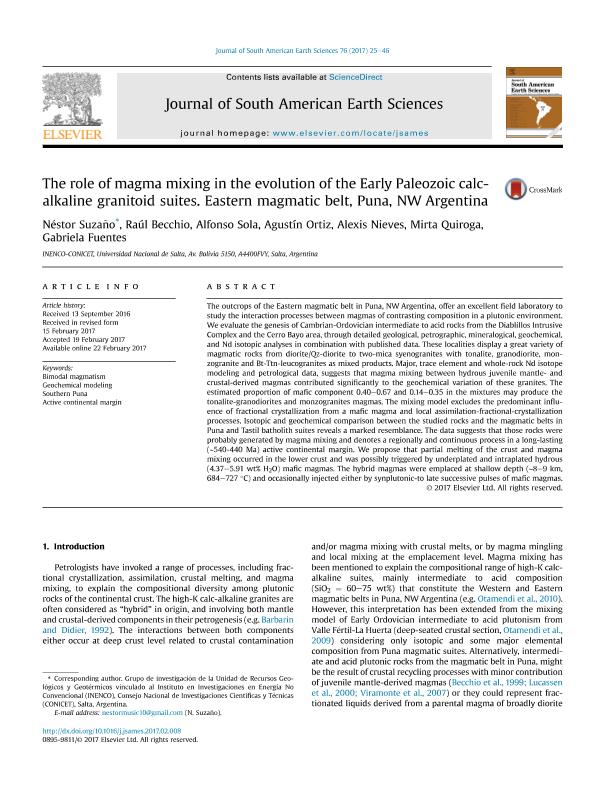Artículo
The role of magma mixing in the evolution of the Early Paleozoic calc-alkaline granitoid suites. Eastern magmatic belt, Puna, NW Argentina
Suzaño, Nestor Omar ; Becchio, Raul Alberto
; Becchio, Raul Alberto ; Sola, Alfonso Manuel
; Sola, Alfonso Manuel ; Ortiz Yañez, Agustín
; Ortiz Yañez, Agustín ; Nieves, Alexis Iván Angel
; Nieves, Alexis Iván Angel ; Quiroga, Mirta Fátima
; Quiroga, Mirta Fátima ; Fuentes, María Gabriela
; Fuentes, María Gabriela
 ; Becchio, Raul Alberto
; Becchio, Raul Alberto ; Sola, Alfonso Manuel
; Sola, Alfonso Manuel ; Ortiz Yañez, Agustín
; Ortiz Yañez, Agustín ; Nieves, Alexis Iván Angel
; Nieves, Alexis Iván Angel ; Quiroga, Mirta Fátima
; Quiroga, Mirta Fátima ; Fuentes, María Gabriela
; Fuentes, María Gabriela
Fecha de publicación:
07/2017
Editorial:
Pergamon-Elsevier Science Ltd
Revista:
Journal of South American Earth Sciences
ISSN:
0895-9811
Idioma:
Inglés
Tipo de recurso:
Artículo publicado
Clasificación temática:
Resumen
The outcrops of the Eastern magmatic belt in Puna, NW Argentina, offer an excellent field laboratory to study the interaction processes between magmas of contrasting composition in a plutonic environment. We evaluate the genesis of Cambrian-Ordovician intermediate to acid rocks from the Diablillos Intrusive Complex and the Cerro Bayo area, through detailed geological, petrographic, mineralogical, geochemical, and Nd isotopic analyses in combination with published data. These localities display a great variety of magmatic rocks from diorite/Qz-diorite to two-mica syenogranites with tonalite, granodiorite, monzogranite and Bt-Ttn-leucogranites as mixed products. Major, trace element and whole-rock Nd isotope modeling and petrological data, suggests that magma mixing between hydrous juvenile mantle- and crustal-derived magmas contributed significantly to the geochemical variation of these granites. The estimated proportion of mafic component 0.40–0.67 and 0.14–0.35 in the mixtures may produce the tonalite-granodiorites and monzogranites magmas. The mixing model excludes the predominant influence of fractional crystallization from a mafic magma and local assimilation-fractional-crystallization processes. Isotopic and geochemical comparison between the studied rocks and the magmatic belts in Puna and Tastil batholith suites reveals a marked resemblance. The data suggests that those rocks were probably generated by magma mixing and denotes a regionally and continuous process in a long-lasting (∼540-440 Ma) active continental margin. We propose that partial melting of the crust and magma mixing occurred in the lower crust and was possibly triggered by underplated and intraplated hydrous (4.37–5.91 wt% H2O) mafic magmas. The hybrid magmas were emplaced at shallow depth (∼8–9 km, 684–727 °C) and occasionally injected either by synplutonic-to late successive pulses of mafic magmas.
Archivos asociados
Licencia
Identificadores
Colecciones
Articulos(CIGEOBIO)
Articulos de CENTRO DE INVESTIGACIONES DE LA GEOSFERA Y BIOSFERA
Articulos de CENTRO DE INVESTIGACIONES DE LA GEOSFERA Y BIOSFERA
Articulos(INENCO)
Articulos de INST.DE INVEST.EN ENERGIA NO CONVENCIONAL
Articulos de INST.DE INVEST.EN ENERGIA NO CONVENCIONAL
Articulos(SEDE CENTRAL)
Articulos de SEDE CENTRAL
Articulos de SEDE CENTRAL
Citación
Suzaño, Nestor Omar; Becchio, Raul Alberto; Sola, Alfonso Manuel; Ortiz Yañez, Agustín; Nieves, Alexis Iván Angel; et al.; The role of magma mixing in the evolution of the Early Paleozoic calc-alkaline granitoid suites. Eastern magmatic belt, Puna, NW Argentina; Pergamon-Elsevier Science Ltd; Journal of South American Earth Sciences; 76; 7-2017; 25-46
Compartir
Altmétricas



